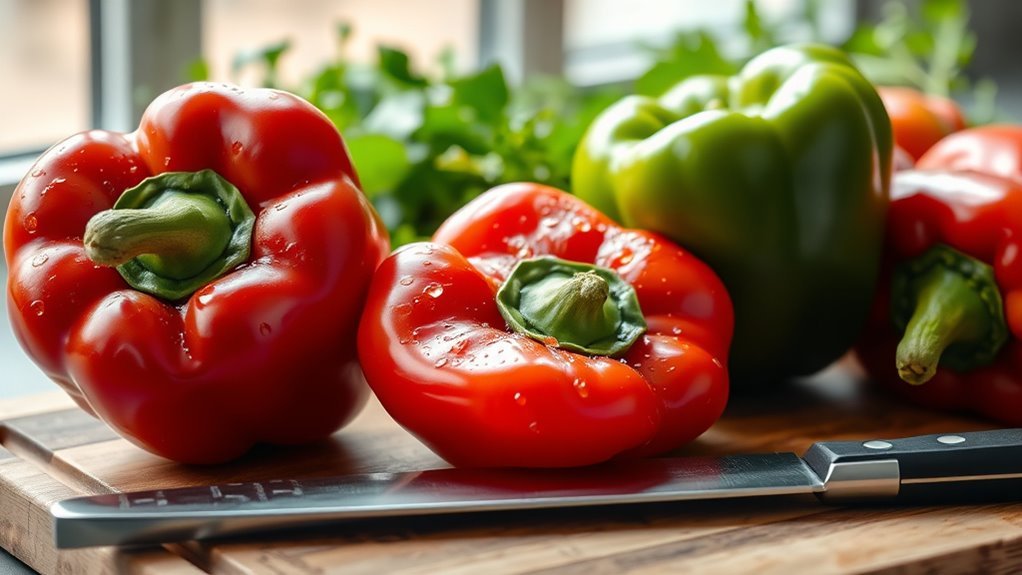Yes, peppers are keto-friendly! They’re low in carbohydrates and high in vitamins A and C, making them a nutritious choice for your low-carb diet. For example, bell peppers have about 6 grams of carbs per cup, while jalapeños contain only around 4 grams. Plus, their fiber content can aid digestion and promote satiety. By incorporating different types of peppers into your meals, you can enjoy delicious dishes while staying within keto limits. There’s much more to explore about how to use them effectively!
Understanding the Keto Diet

The ketogenic diet, often referred to as the keto diet, is a low-carbohydrate, high-fat eating plan that aims to shift your body’s metabolism from burning glucose to burning fat for energy. The core keto principles involve drastically reducing carbohydrate intake while increasing fat consumption, putting your body into a state known as ketosis. During this process, your body becomes fat-adapted, meaning it learns to efficiently use fat as its primary energy source. This adaptation can lead to various benefits, including weight loss and improved mental clarity. While the keto diet offers freedom from traditional dietary restrictions, it’s essential to approach it thoughtfully, ensuring you maintain a balanced intake of nutrients for overall health and well-being.
Nutritional Breakdown of Peppers

When considering if peppers fit into your keto diet, it’s essential to look at their carbohydrate content and overall nutritional profile. Peppers are low in carbs, making them a suitable choice for keto enthusiasts, while also providing a wealth of vitamins and minerals. Understanding these factors can help you make informed decisions about including peppers in your meals.
Carbohydrate Content Analysis
Peppers, whether sweet or spicy, are surprisingly low in carbohydrates, making them a great choice for those following a keto diet. When carb counting, you’ll find that most pepper varieties, like bell peppers and jalapeños, contain between 2 to 6 grams of carbs per 100 grams. This low carbohydrate content allows you to enjoy them without greatly impacting your daily carb limit. For instance, one medium bell pepper has roughly 6 grams of carbs, while a jalapeño has only about 1 gram. Incorporating these vibrant veggies into your meals can add flavor and nutrition without hindering your keto lifestyle. So, feel free to include a variety of peppers in your diet and spice up your meals guilt-free!
Vitamin and Mineral Profile
Not only are peppers low in carbs, but they also boast an impressive array of vitamins and minerals that can enhance your overall health. Different pepper varieties, like bell peppers and jalapeños, are rich in vitamins A and C, which play key roles in immune function and skin health. Additionally, they contain essential minerals such as potassium and magnesium, supporting heart health and muscle function. The antioxidants found in peppers can aid in vitamin absorption, improving your body’s ability to utilize these nutrients effectively. Incorporating a variety of peppers into your keto diet can not only diversify your meals but also provide a nutrient boost that supports your health goals while keeping carbs in check.
Types of Peppers and Their Carb Content

Understanding the carb content of different types of peppers can be essential for anyone following a keto diet. Various pepper varieties offer distinct carb counts, allowing you to make informed choices. For instance, bell peppers have about 6 grams of carbs per cup, while jalapeños contain roughly 4 grams. If you’re looking for low-carb options, consider poblano peppers, which have around 5 grams per cup. On the other hand, sweeter varieties like red peppers can contain up to 9 grams. By examining these carb comparisons, you can easily incorporate peppers into your meals while staying within your carb limits. Embracing peppers can enhance your dishes without derailing your keto goals, providing flavor and versatility.
Health Benefits of Peppers on a Keto Diet
While you might focus on carb counts when following a keto diet, the health benefits of incorporating peppers into your meals shouldn’t be overlooked. Different pepper varieties, like bell peppers and jalapeños, offer not just flavor but also essential nutrients. They’re low in calories and rich in vitamins A and C, which support immune function and skin health. Additionally, peppers contain antioxidants that may reduce inflammation and promote heart health. Their fiber content aids digestion, helping you feel satisfied without derailing your keto goals. Embracing these vibrant vegetables can enhance your meals while contributing to your overall well-being. So, don’t just count carbs—consider the nutritional advantages that peppers bring to your keto lifestyle!
How to Incorporate Peppers Into Keto Meals
Incorporating peppers into your keto meals is a fantastic way to enhance flavor and nutrition without adding excessive carbs. You can whip up a delicious pepper stir fry with your favorite low-carb veggies and protein. Stuffed peppers make for a satisfying dish, filled with cheese and ground meat. For a rejuvenating side, try pepper salads that combine various colors and textures. Roasted peppers add depth to any meal, while pepper dips can serve as great snacks. Don’t forget about hearty pepper soups, perfect for chilly days. Grilled peppers can elevate your summer barbecues, and for a fun twist, create pepper tacos using lettuce wraps. These versatile options keep your meals exciting and keto-friendly!
Comparing Bell Peppers and Hot Peppers
When comparing bell peppers and hot peppers, it’s essential to evaluate their nutritional profiles and culinary uses. Both types offer unique flavors and health benefits, but they serve different purposes in the kitchen. Here are three key differences:
- Nutritional Content: Bell pepper varieties are generally lower in heat and calories, making them versatile for salads or dips.
- Flavor Profiles: Hot peppers bring a range of heat levels, from mild to fiery, adding spice to dishes.
- Culinary Uses: While bell peppers are often used raw or roasted, hot peppers can be used fresh, dried, or in sauces, catering to various flavor preferences.
Understanding these differences can help you make informed choices for your keto meals while enjoying the freedom of culinary exploration.
The Role of Fiber in Peppers
Peppers, whether bell or hot, are not just flavorful additions to your meals; they also provide a significant amount of dietary fiber. This fiber plays an essential role in supporting your digestive health, helping to regulate bowel movements and prevent constipation. By including peppers in your diet, you’re not only enjoying their vibrant taste but also reaping fiber benefits that can aid in weight management and lower cholesterol levels. Fiber-rich foods like peppers can keep you feeling fuller longer, which is especially important for those following a keto lifestyle. So, when you add peppers to your plate, you’re making a choice that contributes to both flavor and health, giving you the freedom to enjoy delicious, nutritious meals.
Cooking Methods for Keto-Friendly Pepper Dishes
Whether you’re sautéing, roasting, or grilling, there are plenty of keto-friendly cooking methods that can bring out the best in peppers. Here are three delicious techniques to try:
Discover the keto-friendly cooking methods that elevate the flavor of peppers—sauté, roast, or grill for delicious results!
- Roasting Peppers: This method enhances natural sweetness, making them perfect for sauces or as sides. Just toss them in olive oil, season, and roast until charred.
- Sautéed Peppers: Quick and easy, sautéed peppers can be a fantastic addition to your pepper stir fry or as a topping for stuffed peppers.
- Grilled Peppers: Grilling gives peppers a smoky flavor, ideal for pepper dips or dressings. Just marinate them for extra zest before grilling.
Experiment with these techniques, and you’ll discover the versatility of peppers in your keto-friendly meals!
Common Misconceptions About Peppers on Keto
You might think all peppers are too high in carbs for a keto diet, but that’s not always the case. In fact, many peppers are nutrient-dense and can fit nicely into your meal plan, depending on how you prepare them. Understanding their carb content and the impact of different cooking methods can help clear up these common misconceptions.
Carb Content Misunderstandings
While many people associate a low-carb diet with strict limitations on certain vegetables, misconceptions about the carb content of peppers can lead to unnecessary confusion. Here are three common carb misconceptions regarding peppers:
- All peppers are high in carbs: In reality, most peppers, especially bell peppers, are quite low in carbs, making them suitable for keto.
- Serving sizes don’t matter: It’s important to evaluate serving sizes; a modest amount of peppers can fit nicely into your carb limits.
- Peppers contain hidden sugars: While some fruits are higher in sugar, peppers primarily contain natural sugars in minimal amounts.
Understanding these points can empower you to enjoy peppers without guilt or confusion, freeing you to incorporate them into your keto lifestyle.
Nutrient Density Benefits
Peppers aren’t just low in carbs; they’re also packed with nutrients that can support your health on a keto diet. These vibrant vegetables, especially varieties like bell peppers, are rich in vitamins A and C, antioxidants, and fiber. This nutrient density can enhance your nutrient absorption, helping your body better utilize the healthy fats you’re consuming. By including peppers in your meals, you’re not only adding flavor but also boosting your overall health optimization. The misconception that all vegetables are off-limits on keto overlooks how nutrient-rich options like peppers can play an essential role in your dietary freedom. Embracing their benefits can help you maintain a balanced, nourishing approach to your keto journey.
Cooking Methods Influence
When reflecting on how to incorporate peppers into a keto diet, it’s important to recognize that cooking methods can greatly influence their nutritional profile and carb content. Here are three popular techniques to explore:
- Grilling Techniques: This method enhances the natural sweetness of peppers, minimizing the need for added sugars or sauces.
- Roasting Flavors: Roasting peppers can intensify their flavor, making them a delicious addition to salads or keto-friendly dishes while keeping carbs low.
- Sautéing Options: Quick sautéing with healthy fats can preserve nutrients and allow you to experiment with various seasoning varieties, creating diverse and satisfying meals.
Don’t forget to reflect on stuffing ideas, like using cream cheese or meat, to keep your meals exciting while staying within your carb limits!
Final Thoughts on Peppers and Keto
Although many people on a keto diet might be concerned about carbohydrate intake, peppers can actually be a nutritious addition to their meal plans. Their versatility makes them perfect for keto meal planning, as they can be enjoyed raw, roasted, or sautéed. With low net carbs and high fiber content, peppers provide essential vitamins and antioxidants, supporting overall health. Incorporating different types, like bell peppers or jalapeños, can enhance flavor without compromising your carb limits. Whether you’re looking for a crunchy snack or a colorful addition to your dishes, peppers can fit seamlessly into your keto lifestyle. So, embrace the freedom to enjoy these vibrant vegetables while staying on track with your dietary goals.


